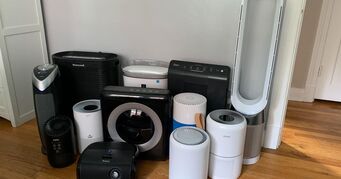|
It's now understood the high potential of COVID exposure is inside a building or home. The lighter aerosol particles travel room to room throughout your home. A COVID carrier will expose others in the home 53% of the time within 7 days. Ventilation is key in minimizing COVID exposure from aerosol particles.
Homes are vulnerable. Housing is expensive and scarce. This forces denser living conditions. Any household member that may be exposed to the public or coworkers inside a building, will have the highest rate of exposure. |
|
Ventilation Strategy - A Practical Approach
|
A good ventilation system greatly minimizes aerosol transmission of the COVID virus. This is accomplished through dilution and filtration. Ducting systems can also dry-out the virus rendering it non-viral.
We've taken a practical approach that anyone can implement. Lets explore options. WARNING - If you suspect someone is COVID infected, further strategies must be considered developing upstream/downstream control of ventilation. Watch Videos below.
|
|
Ventilation Solutions

Open Windows
CDC is recently promoting the importance of making your home COVID safer with ventilation with an open window strategy. An open window will create increase natural airflow. This will dilute the air in the home reducing the concentration of COVID airborne or aerosol virus. It's understood that they will cause comfort issues when its hot or cold outside creating discomfort.
Read more from CDC Website on Open window ventilation.
CDC is recently promoting the importance of making your home COVID safer with ventilation with an open window strategy. An open window will create increase natural airflow. This will dilute the air in the home reducing the concentration of COVID airborne or aerosol virus. It's understood that they will cause comfort issues when its hot or cold outside creating discomfort.
Read more from CDC Website on Open window ventilation.
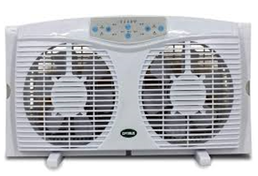
FANS, portable, window, startionary
Ceiling fans or portable fans along with an open window is effective in diluting air and airborne particles. These should be strategically placed in areas of active occupancy to activate circulation. Window fans are advantegeous in integrating outdoor air. This may come at the cost of comfort and higher energy costs.
Ceiling fans or portable fans along with an open window is effective in diluting air and airborne particles. These should be strategically placed in areas of active occupancy to activate circulation. Window fans are advantegeous in integrating outdoor air. This may come at the cost of comfort and higher energy costs.
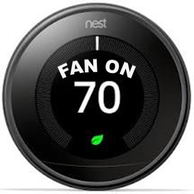
Central HVAC Strategy #1 - FAN-ON
If you have a central heating, cooling system, a very simple strategy is to set your thermostat to a FAN-ON. This will ventilate all living areas with supply vents. This will effectively dilute the air reducing the concentration of the COVID virus potential. There has been more evidence that this forced airflow can dry the virus making it non-viral. It is recommended to operate several hours during waking times and occupancy of home.
If you have a central heating, cooling system, a very simple strategy is to set your thermostat to a FAN-ON. This will ventilate all living areas with supply vents. This will effectively dilute the air reducing the concentration of the COVID virus potential. There has been more evidence that this forced airflow can dry the virus making it non-viral. It is recommended to operate several hours during waking times and occupancy of home.
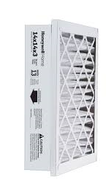
Central HVAC Strategy #2 - MERV-13 Filters
Central heating/cooling systems filters can trap airborne particles. There is a range of air filters that control trapping of airborne particles. MERV ratings stands for Minimum Energy Rating Value. The ratings denotes the abilility to trap smaller particles. MERV 1-7 traps dust, lint & pollen, MERV 8 will trap smaller mites & spores, MERV 11 - Pet dander, smoke & smog., MERV 13 - can trap .03 microns like bacteria & virus carrier.
Central heating/cooling systems filters can trap airborne particles. There is a range of air filters that control trapping of airborne particles. MERV ratings stands for Minimum Energy Rating Value. The ratings denotes the abilility to trap smaller particles. MERV 1-7 traps dust, lint & pollen, MERV 8 will trap smaller mites & spores, MERV 11 - Pet dander, smoke & smog., MERV 13 - can trap .03 microns like bacteria & virus carrier.
|
As you can see MERV 13 filter can be effective at capturing most small particles at .3 microns. This can control ventiliation of the COVID virus. Caution - Before you run out to swap out your HVAC filter with a MERV 13 filter, be aware MERV 13 filters can be thicker and will restrict airflow. MERV 13 filters can be 1 to 3 inches thick, so you may have a form factor limitation with filter slot size. MERV13 will be more restrictive reducing airflow. Restriction could have severe consequences reducing delivery of conditioned air and could cause evaptor coils to "freeze up" when running the AC. Its highly recommend to work with a licensed HVAC contractor prior to installing a MERV 13 filter.
|
|
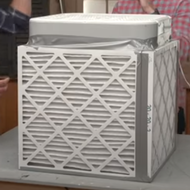
DIY - Room Air Purifiers
There have been some great affordable do-it-yourself solutions even to the meekest of handyman. Its a box fan, four MERV 13 filters and duct tape. This can move 900 cubic feet a minute of ventilated air on high speed. This translates to about 3 air changes per hour for a 2,500 sq. ft. home. Watch the video below for more information on how to make your own air filtration system. Also good information on MERV 13 filters.
There have been some great affordable do-it-yourself solutions even to the meekest of handyman. Its a box fan, four MERV 13 filters and duct tape. This can move 900 cubic feet a minute of ventilated air on high speed. This translates to about 3 air changes per hour for a 2,500 sq. ft. home. Watch the video below for more information on how to make your own air filtration system. Also good information on MERV 13 filters.
|
Expert Bill Warren - Ventilation Strategies for your home
|
Harvard Professor Joseph Allen on ventilation for buildings and homes
|
Create your own air purifing ventilation system with a box fan and MERV 13 filters
|

